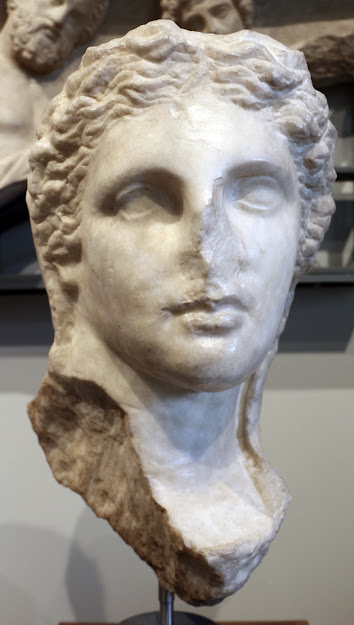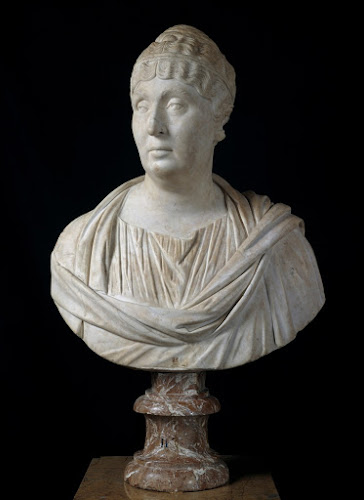 |
| Hellenistic Greek Culture Head of a Woman from a Funeral Relief 350-300 BC marble Museo Barracco di Scultura Antica, Rome |
Hellenistic Greek Culture
Head of a Woman
210-190 BC
marble
Art Institute of Chicago
Hellenistic Greek Culture
Roundel with Idealized Head of Alexander the Great
3rd-2nd century BC
gold
Antikensammlung, Berlin
Hellenistic Greek Culture
Portrait of a Ruler as Dionysus
150-50 BC
bronze
Museo Archeologico Nazionale, Florence
Hellenistic Greek Culture
Portrait of Mithridates VI Eupator
(Tetradrachma of the Pontic Empire)
86-85 BC
silver
Art Institute of Chicago
Roman Empire
Portrait of Gaius Caesar, age seven
(grandson of Emperor Augustus)
13 BC
marble
Museo del Prado, Madrid
Roman Empire
Herm of Homer
AD 50-75
marble
Museo del Prado, Madrid
Standing aloof in giant ignorance,
Of thee I hear and of the Cyclades,
Of thee I hear and of the Cyclades,
As one who sits ashore and longs perchance
To visit dolphin-coral in deep seas.
So thou wast blind – but then the veil was rent,
For Jove uncurtained Heaven to let thee live,
And Neptune made for thee a spumy tent,
And Pan made sing for thee his forest-hive.
Aye on the shores of darkness there is light,
And precipices show untrodden green,
There is a budding morrow in midnight,
There is a triple sight in blindness keen –
Such seeing hadst thou, as it once befell
To Dian, Queen of Earth, and Heaven, and Hell.
– John Keats (1818)
"I have written to George for some Books – shall learn Greek, and very likely Italian – and in other ways prepare myself to ask Hazlitt in about a year's time the best metaphysical road I can take. For although I take poetry to be Chief, there is something else wanting to one who passes his life among Books and thoughts on Books – I long to feast upon old Homer as we have upon Shakespeare, and as I have lately upon Milton. If you understand Greek, and would read me passages, now and then explaining their meaning, t'would be, from its mistiness, perhaps a greater luxury than reading the thing oneself."
– John Keats, from a letter to J.H. Reynolds, 27 April 1818
Roman Empire
Portrait of a Young Man
(ancient head added to 16th-century bust
as one of twelve so-called Emperors
presented by Pope Pius V to Phillip II of Spain)
AD 65-70
marble
Museo del Prado, Madrid
Roman Empire
Portrait of a Young Man
(ancient head added to 16th-century bust
as one of twelve so-called Emperors
presented by Pope Pius V to Phillip II of Spain)
AD 100
marble
Museo del Prado, Madrid
Roman Empire
Portrait of a Soldier
(ancient head added to 16th-century bust
as one of twelve so-called Emperors
presented by Pope Pius V to Phillip II of Spain)
AD 105-115
marble
Museo del Prado, Madrid
Roman Empire
Portrait of Vibia Sabina, wife of Emperor Hadrian
AD 130
marble
Museo del Prado, Madrid
Roman Empire
Portrait of Emperor Hadrian as Hero
(ancient head added to 16th-century bust)
AD 136
marble
Museo del Prado, Madrid
Roman Empire
Portrait of a Woman
AD 150-155
marble
Museo del Prado, Madrid
Roman Empire
Bust of Homer
AD 150-175
marble
Museo del Prado, Madrid
Roman Empire
Portrait of a Man
AD 170-175
marble
Museo Archeologico Nazionale, Venice













